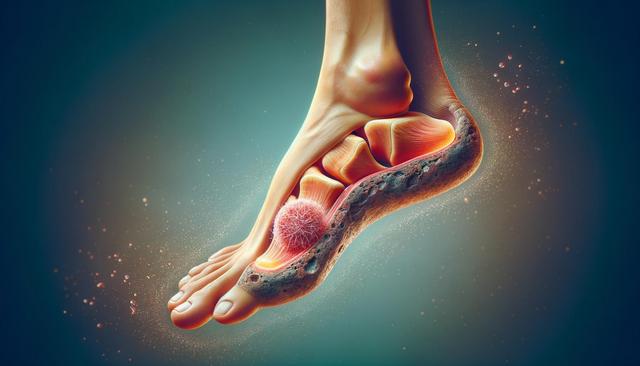Understanding Plantar Callus Development
A plantar callus is a thickened area of skin that usually forms on the bottom of the foot due to repeated friction or pressure. This condition is commonly seen in people who spend long hours on their feet, wear ill-fitting shoes, or walk barefoot frequently. The skin responds to repeated stress by producing more keratin, creating a dense, rough patch. While this is a protective mechanism, it can become problematic when the hard skin begins to cause discomfort or pain during walking or standing. Plantar callus on foot is particularly common around the heel and ball of the foot, where pressure is greatest.
Not all thickened skin on the foot is a plantar callus, so it’s essential to distinguish it from other conditions like corns or warts. A callus is typically broader, less defined, and not as inflamed as a corn. It also tends to have a more yellowish tone and lacks the pinpoint black dots seen in warts. Knowing the difference helps ensure proper plantar callus treatment and avoids unnecessary or ineffective remedies.
Common Causes and Risk Factors
Several factors contribute to the formation of a plantar callus. Understanding these can help in both treatment and prevention. The most common causes include:
- Wearing shoes that are too tight or lack proper cushioning
- Walking or standing for extended periods
- Having abnormal foot mechanics, such as flat feet or high arches
- Engaging in high-impact physical activities without supportive footwear
- Going barefoot on hard surfaces frequently
People with certain medical conditions like diabetes or arthritis may also be more prone to developing a plantar callus on foot due to changes in skin texture and sensation. In such cases, it’s particularly important to monitor foot health closely to prevent complications. Regular foot exams, especially for those with reduced sensation, can help identify problem areas early and initiate timely plantar callus removal if needed.
Effective Plantar Callus Treatment Options
There are several approaches to managing and treating a plantar callus, ranging from home remedies to professional care. Initial treatment often involves reducing the factors contributing to excess friction and pressure. Some common methods include:
- Using cushioned insoles or gel pads to redistribute pressure
- Wearing properly fitted, supportive footwear
- Soaking feet in warm water to soften the callused skin
- Gently exfoliating the area with a pumice stone or foot file
Over-the-counter creams containing urea or salicylic acid can also aid in softening the callus, allowing for easier removal. However, these should be used with caution, especially by individuals with sensitive skin or underlying health conditions. For more severe or painful cases, consulting a podiatrist is advisable. A healthcare professional can safely perform plantar callus removal using sterile tools and may recommend custom orthotics to prevent recurrence.
Preventing Recurrence of a Plantar Callus
Once a plantar callus has been treated, ongoing care is essential to prevent it from returning. Prevention strategies focus on minimizing repetitive pressure and friction on the sole. Here are some practical tips:
- Choose shoes with adequate arch support and cushioning
- Avoid high heels or narrow-toed footwear that compresses the toes
- Use moisture-wicking socks to reduce friction and keep feet dry
- Alternate footwear to give shoes time to air out and retain shape
- Maintain a healthy weight to reduce stress on the feet
Regular foot care, such as moisturizing and gentle exfoliation, can also help keep skin smooth and less prone to thickening. Individuals with foot deformities or gait abnormalities may benefit from a biomechanical assessment to address underlying issues contributing to callus formation. Involving a foot care specialist early can go a long way in long-term prevention.
When to Seek Professional Help
While many cases of plantar callus can be managed at home, certain signs indicate the need for professional evaluation. Seek medical advice if:
- The callus becomes increasingly painful or inflamed
- There is bleeding, cracking, or signs of infection
- You have diabetes or poor circulation and notice any unusual skin changes
- Home treatments fail to provide relief after several weeks
- You experience recurrent calluses despite preventive measures
In these situations, a podiatrist can provide a more comprehensive approach to plantar callus treatment. This may include debridement, prescription medications, or custom orthotics tailored to your foot structure. Timely intervention not only relieves discomfort but also prevents further complications that could impair mobility or lead to infections, especially in vulnerable individuals.
Conclusion: Managing Foot Health Proactively
Dealing with a plantar callus involves more than just removing tough skin—it requires a proactive approach to foot care. By understanding the causes, applying effective treatment strategies, and committing to preventive measures, individuals can significantly reduce discomfort and maintain healthier feet. Whether you’re frequently on your feet, an active individual, or someone managing a chronic condition, regular foot assessments and proper footwear choices are key. If persistent issues arise, consulting a healthcare professional ensures safe and effective plantar callus removal and long-term relief.












